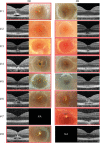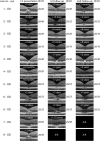Incidence and long-term outcome of laser pointer maculopathy in children
- PMID: 36670265
- PMCID: PMC10313552
- DOI: 10.1007/s10792-023-02638-w
Incidence and long-term outcome of laser pointer maculopathy in children
Abstract
Purpose: Single center study to evaluate the incidence and long-term outcome of laser pointer maculopathy (LPM).
Methods: Medical records of 909,150 patients visiting our institution between 2007 and 2020 were screened in our electronic patient record system using the keywords "laserpointer," "laser pointer," and "solar."
Results: Eight patients (6/2 male/female, 11 eyes) with a history of LPM were identified by fundoscopy and optical coherence tomography (OCT), all of whom were children (6/2 male/female). Mean age at injury was 12.1 years (range 6-16). Five children (62.5%) were injured between 2019 and 2020, three (37.5%) between 2007 and 2018. Median best-corrected visual acuity (BCVA) of affected eyes at first presentation was 20/25 (range 20/50-20/16). Follow-up examination was performed in seven children (10 eyes) with a median follow-up period of 18 months (range 0.5-96). BCVA improved in 4 children (5 eyes; BCVA at follow-up 20/22.5, range 20/40-20/16). Three of these four children were treated with oral steroids. OCT revealed acute signs such as intraretinal fluid to resolve quickly, while outer retinal disruption persisted until the last follow-up in eight of eleven eyes. These lesions resembled lesions of patients with solar retinopathy of which seven cases (11 eyes) were identified between 2007 and 2020.
Conclusion: Readily available consumer laser pointers can damage the retina and the underlying retinal pigment epithelium, possibly leading to long-lasting visual impairments. The number of laser pointer injuries has increased over the last years. Therefore, access to laser pointers for children should be strictly controlled.
Keywords: Children; Laser injury; Laser pointer; Retinal damage; Solar retinopathy.
© 2023. The Author(s).
Conflict of interest statement
The authors declare no competing interests.
The authors have no competing interest to disclose.
Figures



Similar articles
-
Laser Pointer-Induced Maculopathy: More Than Meets the Eye.J Pediatr Ophthalmol Strabismus. 2018 Sep 20;55(5):312-318. doi: 10.3928/01913913-20180405-01. Epub 2018 Jun 19. J Pediatr Ophthalmol Strabismus. 2018. PMID: 29913024
-
Laser pointer maculopathy - on the rise?Acta Ophthalmol. 2018 Nov;96(7):749-754. doi: 10.1111/aos.13856. Epub 2018 Oct 2. Acta Ophthalmol. 2018. PMID: 30280504
-
The New Pretender: A Large UK Case Series of Retinal Injuries in Children Secondary to Handheld Lasers.Am J Ophthalmol. 2016 Nov;171:88-94. doi: 10.1016/j.ajo.2016.08.027. Epub 2016 Aug 31. Am J Ophthalmol. 2016. PMID: 27590121
-
Long-term changes in optic coherence tomography in a child with laser pointer maculopathy: A case report and mini review.Photodiagnosis Photodyn Ther. 2017 Jun;18:264-266. doi: 10.1016/j.pdpdt.2017.03.012. Epub 2017 Mar 24. Photodiagnosis Photodyn Ther. 2017. PMID: 28347866 Review.
-
Long-term anatomical and functional findings of solar maculopathy.Ir J Med Sci. 2024 Feb;193(1):435-441. doi: 10.1007/s11845-023-03434-2. Epub 2023 Jun 29. Ir J Med Sci. 2024. PMID: 37380832 Review.
Cited by
-
Solar retinopathy: A literature review.Oman J Ophthalmol. 2024 Jun 27;17(2):173-180. doi: 10.4103/ojo.ojo_248_23. eCollection 2024 May-Aug. Oman J Ophthalmol. 2024. PMID: 39132123 Free PMC article. Review.
-
Photic Retinopathy: Diagnosis and Management of This Phototoxic Maculopathy.Life (Basel). 2025 Apr 12;15(4):639. doi: 10.3390/life15040639. Life (Basel). 2025. PMID: 40283193 Free PMC article. Review.
References
-
- Hadler J, Tobares E, Dowell M. Random testing reveals excessive power in commercial laser pointers. J Laser Appl. 2013;25(3):032007. doi: 10.2351/1.4798455. - DOI
-
- Spelsberg H, Hering P, Reinhard T, Sundmacher R. Bilateral scleral thermal injury: complication after skin laser resurfacing. Arch Ophthalmol. 2000;116:1686–1687. - PubMed
MeSH terms
LinkOut - more resources
Full Text Sources
Medical

